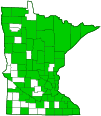Black Knot
(Apiosporina morbosa)
Conservation • Description • Habitat • Ecology • Use • Distribution • Taxonomy
Conservation Status |
|
|||||||
| IUCN Red List | not listed |
|||||||
| NatureServe | not listed |
|||||||
| Minnesota | not listed |
|||||||
Description |
||
Black Knot is a symptom, not the form, of a parasitic fungus, Apiosporina morbosa, infecting living plants of the Prunus genus. Knots (galls) are black, irregular, bumpy swellings clasping and sometimes surrounding the twigs and branches, sometimes the trunk, of cherry and plum trees and shrubs. They are elongated, furrowed, cracked, Spores are produced during extended rainfalls of six hours or more when the temperature is between 60° and 80°F. They are spread by wind and by rain splashing. Where spores land on current season’s growth or wounded tissue an infection occurs. Growth the first year is very slow. The infection first appears in the late summer as a small, warty, greenish-brown or light brown swelling. The fungus overwinters in this state. The following spring the swelling turns olive green and velvety. Over this growing season (the second year of infection) the knot grows rapidly and has a corky texture. Several knots may merge into a single large knot. Eventually, the knot turns black, hard, and brittle. The Black Knot is usually the first symptom of the disease that is noticed. Tissue toward the center of the knot often dies after two years and is invaded by boring insects. The dead gall tissue is colonized by another fungal parasite, Trichothecium roseum, that gives the knot a whitish or pinkish appearance. Young infected twigs die the first year of infection. Older branches may last several years. Infections cause the host to lose vigor and may eventually be fatal. |
||
Similar Species |
||
Habitat and Hosts |
||
American plum, black cherry, and other Prunus species |
||
Ecology |
||
Season |
||
Year-round; sporulation in wet weather |
||
Use |
||
Agricultural pest |
||
Distribution |
||||
|
Sources |
|||
| 5/7/2022 | ||||
Occurrence |
||||
Common and widespread |
||||
Taxonomy |
|||
| Kingdom | Fungi (Fungi) | ||
| Subkingdom | Dikarya | ||
| Phylum | Ascomycota (Sac Fungi) | ||
| Subphylum | Pezizomycotina (Sac Fungi and Lichens) | ||
| Class | Dothideomycetes | ||
Order |
Venturiales | ||
Family |
Venturiaceae | ||
Genus |
Apiosporina | ||
Synonyms |
|||
Botryosphaeria morbosa Cucurbitaria morbosa Dibotryon morbosum Otthia morbosa Plowrightia morbosa Sphaeria morbosa |
|||
Common Names |
|||
Black Knot |
|||
Visitor Photos |
|||||
Share your photo of this fungus. |
|||||
| This button not working for you? Simply email us at info@MinnesotaSeasons.com. Attach one or more photos and, if you like, a caption. |
|||||
Alfredo Colon |
|||||
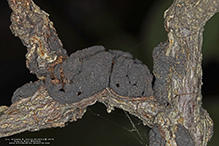 |
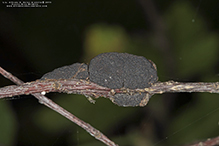 |
||||
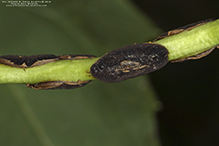 |
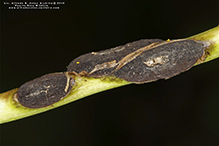 |
||||
MinnesotaSeasons.com Photos |
|||||
On a Twig |
|||||
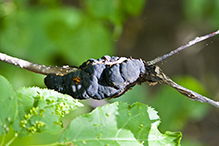 |
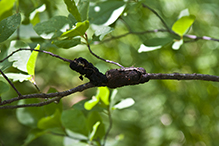 |
||||
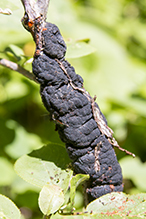 |
|||||
On a Trunk |
|||||
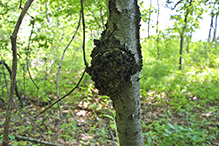 |
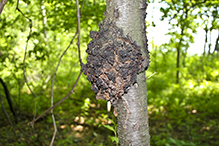 |
||||
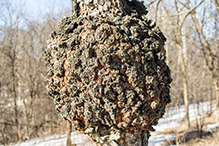 |
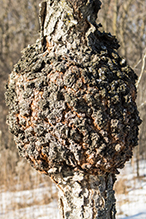 |
||||

Visitor Videos |
|||
Share your video of this fungus. |
|||
| This button not working for you? Simply email us at info@MinnesotaSeasons.com. Attach a video, a YouTube link, or a cloud storage link. |
|||
Other Videos |
|||
| Combat Black Knot City of Fort St. John |
|||
About
Oct 1, 2020 Fort St. John, along with many other areas of British Columbia and Alberta, is experiencing a Black Knot fungus infestation. Black Knot, or Apiosporina morbosa, is a deadly tree fungal disease that attacks predominately plum and cherry trees. The fungus can put the tree’s health at risk, and without treatment, can eventually kill the tree. Learn more at www.fortstjohn.ca/black-knot. |
|||
| Black Knot on Cherries and Plums - James Blake Clemson University - PSA |
|||
About
Jul 19, 2009 Hi, I'm James Blake, Director of the Clemson Extension Home & Garden Information Center. Today we're looking at a disease known as black knot. Were along the edge of the Clemson University Experimental Forest looking at a wild black cherry with some strange black growths on the twigs. This disease is known as black knot caused by the fungus Apiosporina morbosa. It infects cherries and plums. The fungus can infect green shoots but can also enter through wounds. Infection leads to these long, rough galls on the twigs and branches and can even infect the trunks of trees. These galls can range in size from an inch to more than 20 inches. These galls can form on one side of a branch or can encircle the entire branch. When infection circles the entire branch or twig it leads to death beyond the point of the gall. The duration of the complete cycle of this disease is normally 2 years. After infection occurs in the spring, swellings appear in the fall on the current seasons growth. After being dormant during the winter, the fungus resumes growth in spring and the bark splits revealing olive-green fungal tissue covered with spores. These galls turn darker during the summer and fall and then turn hard and black during the winter. In the following spring, another spore stage is produced on the black knots that starts new infections. Management of black knot begins with the selection of resistant cultivars. If any galls form on susceptible varieties these galls should be removed 4 inches below the point of the gall. All infected plant material should be destroyed. For more information on gardening, landscaping, insect and disease problems on your plants, visit the Home & Garden Information Center web site at www.clemson.edu/hgic |
|||
| Black Knot of Plum and Cherry Trees Integrated Pest Management |
|||
About
May 26, 2020 In this video, plant pathologist Ed Zaworski discusses Black knot of plum and cherry trees. Check it out! |
|||
| Black knot fungus tutorial BuckthornMN |
|||
About
Published on Jan 7, 2013 Buckthorn versus cherry trees - black knot fungus grows on cherry trees but not on buckthorn. Learn to Identify and remove black knot fungus from native cherry trees in your woodland. Get rid of buckthorn - not cherry trees |
|||
| BLACK KNOT FUNGUS! bushcraftbartons |
|||
About
Published on Mar 27, 2012 NOTE: 4 days after visiting the shelter good weather came by and started to really melt. Visited a forest that was facing South and not North like my shelter. What a difference. I fell upon something I felt I could share. Showing that this fungus is not Chaga even though they look similar..Please visit our website http://bushcraftbartons.com/ |
|||
| Black Knot alcoopextensionvideo |
|||
About
Uploaded on Feb 25, 2010 Dr. Scott Enebak Auburn University School of Forestry & Wildlife Sciences, discusses the characteristics of common forest diseases. |
|||

Visitor Sightings |
|||||
Report a sighting of this fungus. |
|||||
| This button not working for you? Simply email us at info@MinnesotaSeasons.com. Be sure to include a location. |
|||||
| Alfredo Colon Summer 2019 |
Location: Maplewood Nature Center |
 |
|||
MinnesotaSeasons.com Sightings |
|||||
Bertram Chain of Lakes Regional Park Carpenter St. Croix Valley Nature Center Charles A. Lindbergh State Park Clifton E. French Regional Park Clinton Falls Dwarf Trout Lily SNA Felton Prairie SNA, Bicentennial Unit Forestville/Mystery Cave State Park John Peter Hoffman Spring Brook Valley WMA Lake Alexander Woods SNA, South Unit Mary Schmidt Crawford Woods SNA Minnesota Valley State Recreation Area, Lawrence Unit Nerstrand Big Woods State Park Prairie Creek WMA, Koester Prairie Unit Stanley Eddy Memorial Park Reserve |
|||||

Last Updated:
